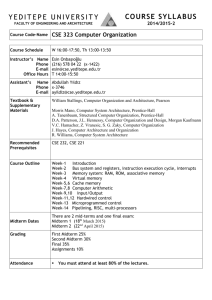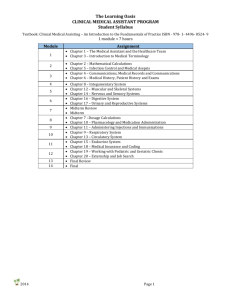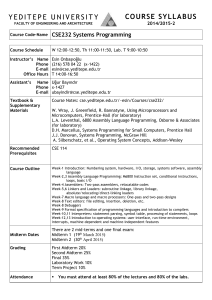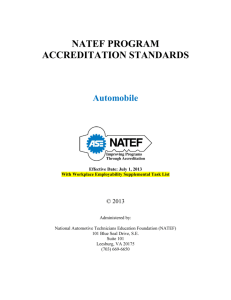CSE 473
advertisement
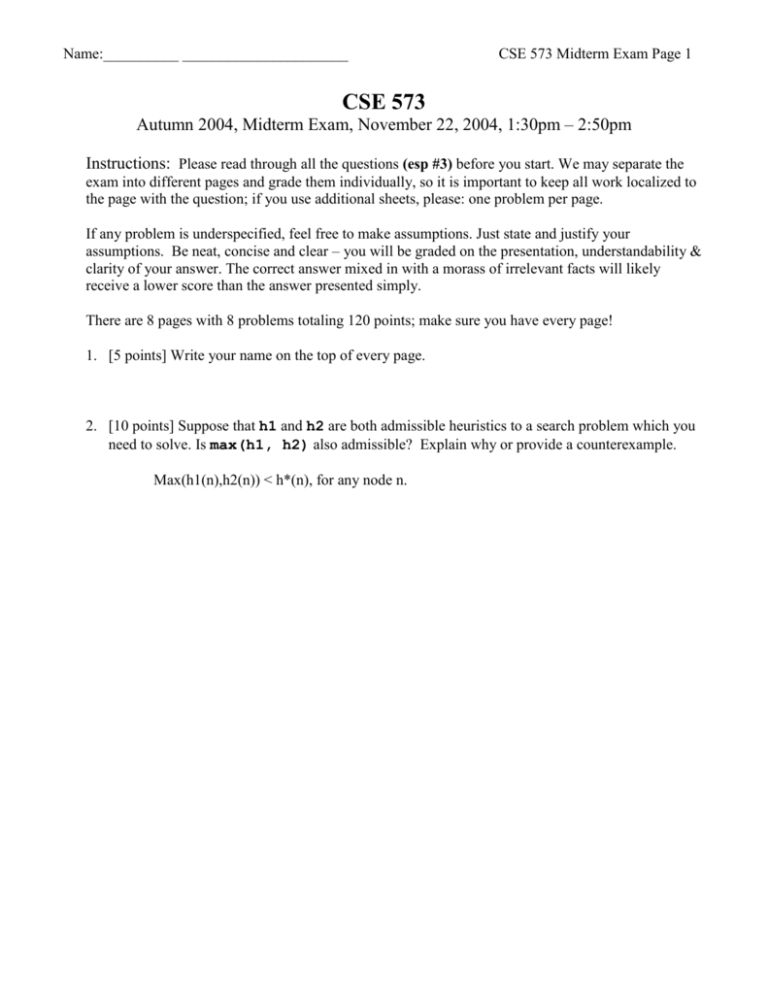
Name:__________ ______________________
CSE 573 Midterm Exam Page 1
CSE 573
Autumn 2004, Midterm Exam, November 22, 2004, 1:30pm – 2:50pm
Instructions: Please read through all the questions (esp #3) before you start. We may separate the
exam into different pages and grade them individually, so it is important to keep all work localized to
the page with the question; if you use additional sheets, please: one problem per page.
If any problem is underspecified, feel free to make assumptions. Just state and justify your
assumptions. Be neat, concise and clear – you will be graded on the presentation, understandability &
clarity of your answer. The correct answer mixed in with a morass of irrelevant facts will likely
receive a lower score than the answer presented simply.
There are 8 pages with 8 problems totaling 120 points; make sure you have every page!
1. [5 points] Write your name on the top of every page.
2. [10 points] Suppose that h1 and h2 are both admissible heuristics to a search problem which you
need to solve. Is max(h1, h2) also admissible? Explain why or provide a counterexample.
Max(h1(n),h2(n)) < h*(n), for any node n.
Name:__________ ______________________
CSE 573 Midterm Exam Page 2
3. [25 points] Consider the N-knights problem. Suppose that you are given
an M x M chessboard and N knights, can you place all of these knights on
the board such that none attack each other? It’s important to know that a
knight moves in an L as illustrated to the right (here the lightly dotted
square represents the knight’s position and the squares with slanted
shading represent the squares which this knight can attack). One way to
build a program to see if N knights can be placed on a board without
attacking each other is as a constraint satisfaction problem. Indeed, there are several such
formulations, for example:
Nk1: let there be N variables, one for the position of each knight, and let the domain for such a
variable be an <x,y> pair denoting it’s location. The constraints would include one saying “for all
variables, A, B if variable A is at <x, y> and variable B is at <u, v> then the two positions cannot
be in a knights move relationship to each other (i.e. (x = u+2 y = v+1) (x = u+1 y = v2) (x = u-1 y=v+2) …) for a total of 8 conjuncts.
Nk2: let there be M2 variables, one for each square (i.e. we’ll use a name like ‘XY’ to denote a
single variable), and let the domain of each variable be an integer in [0, 1] with the understanding
that 0 means no knight on the square and 1 meaning that there is a knight there. The constraints
would include one saying “for all pairs of variables, (XY, UV), if XY + UV=2, then the two
positions cannot be in a knights move relationship to each other (i.e. similar to before (X=U+2
Y=V+1) …) and another of constraints would say that the sum of all M2 variables N.
a. (7 points) List the pros of using Nk1 (instead of Nk2):
Less variables,
Search depth is smaller
Less constraints
b. (7 points) List the pros of using Nk2 (instead of Nk1):
Smaller domain,
Branching factor is smaller
Easy to check consistency
Name:__________ ______________________
CSE 573 Midterm Exam Page 3
c. (5 points) Which formulation will perform better (and why)?
Nk2 is better, because Nk2 has smaller search space.
Nk1 O(M^2N)
Nk2 O(2^(M^2))
In most of the cases, N is big enough to make Nk1 having bigger search space.
Arguing that for some cases, Nk1 is smaller will get partial score.
Arguing about encoding to SAT gets partial score.
Arguing about board edge could reduce the constraints get partial score.
d. (6 points) In both Nk1 and Nk2 we defined “cannot be in a knights move relationship to
each other” in an expression with 8 conjuncts. Ignoring, logically sound transformations
(e.g. using deMorgan’s laws or rewriting the numeric constraints using algebra or
mathematical simplification), is it necessary to test all eight combinations? If not, explain
how many can be eliminated, which ones, and why. If all 8 are necessary, argue why this is
so. If the answer varies from Nk1 to Nk2 explain the answer for both.
Not necessary to check them all.
Nk1: If the assignment of variable follows an order from left-upper to right-lower corner,
then we only need to check those values (coordinates) onward, which is half of the constraints.
So, for <x,y>,
( x u 1 y v 2), ( x u 2 y v 1), ( x u 1 y v 2), ( x u 1 y v 1)
have been eliminated.
Hk2: If the variables are checked/picked with the order described as above, then the
constraints similar to the above would be eliminated too.
Name:__________ ______________________
CSE 573 Midterm Exam Page 4
4. [14 points] Consider the following adversarial search trees. Note that underneath the leaves (e.g.,
nodes c, d, f, & g in Tree I) we have written the value returned by the heuristic evaluation
function.
2
k
h
0
l
o
i
j
m
n
1
6
3
2
p
1
q
9
a. [2 points] Using min-max search on Tree I, what is the value of node a?
3
b. [5 points] Suppose Tree I is searched using alpha-beta search in a depth first fashion. E.g.,
if all nodes were explored, they would be visited in alphabetic order. Would alpha-beta
visit all nodes, or would it prune one or more nodes? Answer “no pruning” or for each
node which does get pruned, say “node X pruned immediately after visiting node Y”.
no prunning
c. [2 points] Using min-max search on Tree II, what is the value of node a?
2
d. [5 points] Answer question b for Tree II.
the subtree rooted on k and j
Name:__________ ______________________
CSE 573 Midterm Exam Page 5
5. [11 points] Use first-order predicate calculus to encode the sentence “Politicians can fool some of
the people all the time, and all of the people some of the time, but they can’t fool all of the people
all of the time.” Use the following predicates: P(x) is true when x is a politician. H(y) is true
when y is a human being (i.e. a person). T(t) is true when t is a time. F(x, y, t) is true
when x fools y at time t.
[p h t
[p t h
[p t h
(P(p) H(h) T(t)) => F(p, h, t)]
(P(p) H(h) T(t)) => F(p, h, t)]
(P(p) H(h) T(t)) => F(p, h, t)]
Variant solutions: p is valid;
Different Orderings of variables are all valid;
Key points: using => instead of using /\
6. [15 points] Suppose you are running a learning experiment on a new algorithm. You have a data
set consisting of 25 examples of each of two classes. You plan to use leave-one-out cross
validation. As a baseline, you run your experimental setup on a simple majority classifier (i.e. a
`dumb’ classifier which ignores the input features and uniformly outputs the class that is in the
majority in the training set.). You expect the majority classifier to score about 50% on leave-oneout cross validation, but to your surprise, it scores zero. Can you explain why?
The one used as test data always be the class that is the minority class in the training set.
Name:__________ ______________________
CSE 573 Midterm Exam Page 6
7. [20 points] In class we defined the Bellman equation for a discounted MDP assuming that the
reward, R, is a function solely of the current state, R(s) and the cost of executing an action
depended solely on the action being executed, C(a).
V*(s) = R(s) + MaxaεA {C(a) + γΣs’εS Pr(s’|a,s)V*(s’)}
Suppose, instead, that the execution cost is a function of source state and action executed: C(s, a).
Furthermore, suppose that the reward is a function of the source state, action executed and the
outcome state: R(s, a, s’). Write the Bellman equation for this case
V*(s) = MaxaεA {C(s,a) + Σs’εS Pr(s’|a,s)[R(s,a,s’)+ γV*(s’)]}
Name:__________ ______________________
CSE 573 Midterm Exam Page 7
8. [20 points] Consider playing tic-tac-toe against an opponent who plays randomly. Specifically,
suppose that the opponent chooses any open space with uniform probability, unless the move is
forced (in which case it makes the obvious correct move).
a. [7 points] Formulate the problem of learning an optimal tic-tac-toe strategy in this case as a
Q-learning task.
Q ( a, s ) Q ( a, s ) ( R( s ) max ( a ' , s' ) Q ( a, s ))
a'
in equilibrium, it converges to Q(a, s ) [
1
max Qa('a' , s' )]
n s'
in a winning state, reward is 1
in a losing state, reward is -1
in a tie state, reward is 0
b. [2 points] Will your program succeed if the opponent plays optimally rather than
randomly?
Still success, because there is no transition model needed
c. [3 points] What if your opponent changed its strategy after playing a while. Under what
condition would your agent adapt to the new strategy?
Yes, if it is still learning (learning rate alpha is not zero, the Q value is not converged, the
exploration function is working)
Name:__________ ______________________
CSE 573 Midterm Exam Page 8
d. [5 points] Is there a way to exploit the fact that the tic-tac-toe board, is symmetric?
(Answer with one clear and concise English sentence, describing what you might do and
another sentence explaining the benefit(s).
Symmetry reduces the state space/ action space, searching faster
e. [3 points] Could symmetry analysis hurt the performance of the learner? (Explain with one
clear and concise English sentence).
If the opponent chooses asymmetric policy, our learning model will not be able to figure it
out. In this case, the performance could be reduced.
